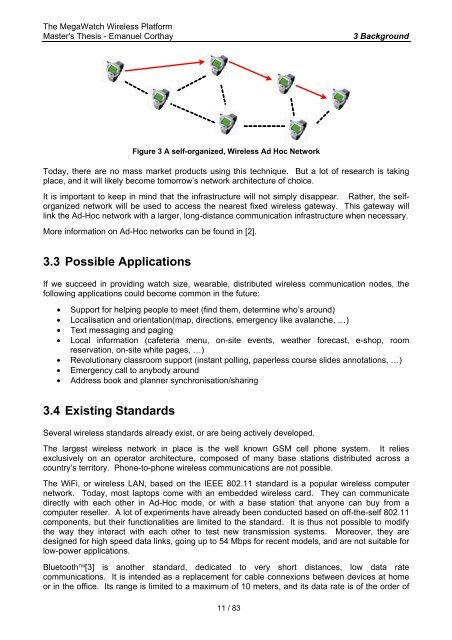Design and Realization of a Prototype Hardware Platform for ...
Design and Realization of a Prototype Hardware Platform for ...
Design and Realization of a Prototype Hardware Platform for ...
Create successful ePaper yourself
Turn your PDF publications into a flip-book with our unique Google optimized e-Paper software.
The MegaWatch Wireless <strong>Plat<strong>for</strong>m</strong>Master's Thesis - Emanuel Corthay3 BackgroundFigure 3 A self-organized, Wireless Ad Hoc NetworkToday, there are no mass market products using this technique. But a lot <strong>of</strong> research is takingplace, <strong>and</strong> it will likely become tomorrow’s network architecture <strong>of</strong> choice.It is important to keep in mind that the infrastructure will not simply disappear. Rather, the sel<strong>for</strong>ganizednetwork will be used to access the nearest fixed wireless gateway. This gateway willlink the Ad-Hoc network with a larger, long-distance communication infrastructure when necessary.More in<strong>for</strong>mation on Ad-Hoc networks can be found in [2].3.3 Possible ApplicationsIf we succeed in providing watch size, wearable, distributed wireless communication nodes, thefollowing applications could become common in the future:• Support <strong>for</strong> helping people to meet (find them, determine who’s around)• Localisation <strong>and</strong> orientation(map, directions, emergency like avalanche, …)• Text messaging <strong>and</strong> paging• Local in<strong>for</strong>mation (cafeteria menu, on-site events, weather <strong>for</strong>ecast, e-shop, roomreservation, on-site white pages, …)• Revolutionary classroom support (instant polling, paperless course slides annotations, …)• Emergency call to anybody around• Address book <strong>and</strong> planner synchronisation/sharing3.4 Existing St<strong>and</strong>ardsSeveral wireless st<strong>and</strong>ards already exist, or are being actively developed.The largest wireless network in place is the well known GSM cell phone system. It reliesexclusively on an operator architecture, composed <strong>of</strong> many base stations distributed across acountry’s territory. Phone-to-phone wireless communications are not possible.The WiFi, or wireless LAN, based on the IEEE 802.11 st<strong>and</strong>ard is a popular wireless computernetwork. Today, most laptops come with an embedded wireless card. They can communicatedirectly with each other in Ad-Hoc mode, or with a base station that anyone can buy from acomputer reseller. A lot <strong>of</strong> experiments have already been conducted based on <strong>of</strong>f-the-self 802.11components, but their functionalities are limited to the st<strong>and</strong>ard. It is thus not possible to modifythe way they interact with each other to test new transmission systems. Moreover, they aredesigned <strong>for</strong> high speed data links, going up to 54 Mbps <strong>for</strong> recent models, <strong>and</strong> are not suitable <strong>for</strong>low-power applications.Bluetooth[3] is another st<strong>and</strong>ard, dedicated to very short distances, low data ratecommunications. It is intended as a replacement <strong>for</strong> cable connexions between devices at homeor in the <strong>of</strong>fice. Its range is limited to a maximum <strong>of</strong> 10 meters, <strong>and</strong> its data rate is <strong>of</strong> the order <strong>of</strong>11 / 83















